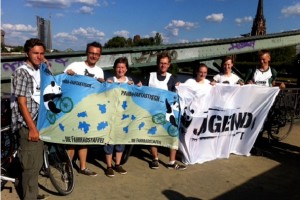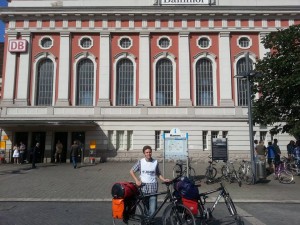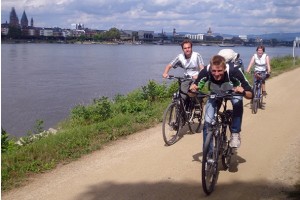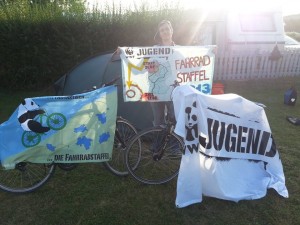All routes headed for Frankfurt
This is the third guest post as part of our series accompanying the WWF Youth Bike Tour this summer. Still having sore muscles from the previous day’s leg Tamara Nausner and her fellow cyclists lost little time to ride on to Frankfurt. It was the last stretch for our guest blogger.
Today is a very special day. The bike tour really are two – one that traverses the country passing through the Eastern states, the other following a route in the West. But both will be merging at the end of today’s stretch. Filled with anticipation we are riding out of Wiesbaden, although our bodies hurt quite a bit. But: no pain, no gain. And after a while I get used to it and can enjoy the journey again along the river Main. I like the route more than the one yesterday because for the most part there is no road and no cars. At one point we even have an abandoned motorway all to ourselves. Some of us are cycling as fast as they can. We are all having fun.
We arrive at Frankfurt quite early. The riders from the Eastern route inform us that they will not be here for another few hours. To pass the time we treat ourselves to ice-cream, play cards and relax in the grass near the Main. Eventually the others arrive. Together we take a picture of the banners of the two teams now united.
For me and some of the others the bicycle relay is over now but the rest will ride on in the spirit of climate-friendly travel. I am so glad I took part and hope that there will be another tour next year. And I also hope that we could help encourage people to think about what they can do to protect our environment.
56 Kilometers turn strangers into friends
This is the second guest post as part of our series accompanying the WWF Youth Bike Tour this summer. Today Tamara Nausner tells us about her day on the road – and that 56 kilometers on a bike need not be the most taxing thing in a day of cycling…
My day starts very early in the morning. Too early. But today there is no time to be tired or lazy. So I’m packing all my luggage onto my bike and ride to the train station. It is so quiet and peaceful at this time in the morning.
Being a little late, my train eventually is on its way to Oberwesel – the starting point for today’s stage of the WWF Youth cycling tour.
What I learn along my journey is that there are no elevators at small stations, so I have to carry my bike up and down the stairs quite a few times. Not that easy with all the luggage.
At half past nine I arrive in the town, which is is located some 80 kilometers West of Frankfurt. I am very excited to meet the two cyclists, who will join me for the tour. And they don’t keep me waiting. I spot them immediately – they are wearing the vests carrying the WWF logo. Then they hand me one, too. Time for a picture of all of us! There is not much around; we eventually opt for an old ruin as a backdrop for our photo.
At last we start day 20 of our tour, which today will bring us to the city of Wiesbaden. But we are not the only ones on the road, framed by vineyards on one side and the river Rhine on the other. Unfortunately there are cars too. So after a while we decide to take a route through the vineyards. There are no other cyclists and no cars. Only a tractor. But very quickly we regret this idea because our path is steeply rising. Eventually we return to our previous route.
The weather is perfect: warm but not too hot, clouds and the sun take it in turns. We enjoy the journey. While riding we get to talk a bit, about everything, and I realize how nice it is to talk to people who have similar interests – protecting the environment being a very big one.
Our destination is getting closer. But before starting off on the final stretch we decide to take a break and have some lunch. That is when I notice for the first time just how tired I am. The rest of the trip is quite tough. Finally we arrive at the train station of Wiesbaden. But even after 56 kilometers on the bike there is no rest for us yet. A photographer is welcoming us, asks for our names and wants to take a couple of pictures. Then, he leaves.
A final short ride along a coarse gravel path to our night quarters turns out to be almost the hardest part of our journey today. But eventually we get there.
The next morning at 10am we are ready for the next leg of our tour. We take a picture and are on our way – to Frankfurt.
From gray to green – biking through Germany’s former industrial heartland
In the second part of our bike blog, Maurice Jurke, who’s part of the WWF’s bike tour across Germany, takes up the story as he encounters some strenuous uphill stretches (the good thing about those, as he points out, is rolling down), sweats it out in the summer heat and cycles through Germany’s former coal-fired industrial heartland which has now been rejuvenated into a green area.
It’s 3:20 pm and I am sitting in a small café in the inner city of Hamm in the western German state of North-Rhine Westphalia. It’s quite well known in Germany and so I expected a big town with and a landscape dominated by the color gray. But as so often this year, I was wrong. Instead, I cycled on a wonderful route from Gütersloh to Hamm.
During the day, I barely rode on streets since a large part of the stretch wound through fields and large forests. I began at 10:15 as usual and I had hoped to arrive after 60 kilometers and 3 1/2 hours. But again I was proven wrong. Literally. I took some wrong turns, and so I had to ride 70 kilometers over several mountains, and arrived after 4 hours. Still a good number, but I was not very happy with my day. It was too hot and I am really thankful for my ice cream and my ice-cooled coke which I’m sipping at the moment. Still, it was a good day, it just could have been better. Well, I hope you had a perfect day. Me? I’m going to take a bath to cool down some more.
Let’ s go gray…uhh I mean green
Another day of biking through Germany and the direction is still south-west. From Hamm, we passed Dortmund and Duisburg, and now we’re visiting Langengeld, a small village at the border of Düsseldorf.
In the last three days, we’ve cycled past plenty of places in Germany’s old industrial heartland in the west. It’s called the Rhein- and Ruhrgebiet in German. There you’ll find big industrial companies and lots of mines and old coal pits. As Germany tries to change its energy policy, increasingly moving away from fossil fuels and towards renewable energy, coal is no longer a big player.
 So you’ll find many old, abandoned and derelict coal mines. In some of these places, city authorities are trying to transform them into old people’s homes. Once gray and polluting, these unpopular mines are being upcycled and are a jewel in the inner cities.
So you’ll find many old, abandoned and derelict coal mines. In some of these places, city authorities are trying to transform them into old people’s homes. Once gray and polluting, these unpopular mines are being upcycled and are a jewel in the inner cities.
That means almost our entire bike route now goes through parks or forests, occasionally cut by some highways or an inner city. Germany, in this regard, has developed well, we think.
And here’s a personal question: what do you think of this development in Germany’s former industrial areas? Have the cities been successful? Would you want to live in this former gray area, which has now painted itself in green?
Water blog Part III – An ocean full of solutions?
In the third and final part of our blog series on water, Julian Claudi looks at initiatives, small and big, around the world that try to tackle the water crisis by advocating more sustainable and efficient uses of water but also various techniques to obtain clean water.
Let’s listen to Vandana Shiva, Indian physicist, environmental activist, recipient of the Right Livelihood Award (the ‘Alternative Nobel Prize’) and author of the book “Water Wars” summing up the problem of the water crisis in India and how it echoes the global water crisis. Shiva addresses both – communities and water companies:
So, for India – and the world – what are the ways out?
“Governments must make a concerted effort to invest inimproving water infrastructure and management […] We must also engage communities, the private sector and civil society in promoting water conservation and water reuse.”
This is Noeleen Heyzer, Executive Secretary of United Nations Economic and Social Commission for Asia and the Pacific (ESCAP), in her speech at the 2010 Asia-Pacific Water Ministers’ forum. She called for
“…the use of simple technologies such as drip agriculture, climate appropriate cropping, rainwater harvesting and grey water reuse [which] can go a long way in increasing our water eco-efficiency.”
But can the world wait for governments to finally start doing “the job” more comprehensively?
It looks like a global solution may be some way off, yet. But there are plenty of grassroots initiatives. Barefoot College in India is an example.
The Barefoot College experts are employing an impressive range of different techniques to obtain clean water: Rain water harvesting (RWH) tanks, dams, solar powered reverse osmosis (R/O) water desalination plants, wells and ponds for ground water recharge obtain clean water.
Some of these work well at a local level, but may not be feasible on large scales. In the case of reverse osmosis (R/O) water desalination plants, it would raise serious concerns:
claims Food & Water Watch, a the Washington, D.C.-based consumer rights NGO, in a special report on reverse osmosis/water desalination:
“Ocean desalination ignores the fact that the water shortages […] are not due to a lack of natural water resources, but rather to shortsighted water policy that focuses on finding new water resources instead of managing existing resources wisely.”
But more sustainable solutions may be facing an uphill struggle. Large-scale desalination is projected to become a highly traded commodity on global markets soon.
“Depleting water supplies, coupled with increasing water demand, are driving the global market for desalination technology, which is expected to reach $52.4 billion by 2020, up 320.3% from $12.5 billion in 2010.“
But even if the trading floors love desalination, the Pacific Institute, an US non-profit research institute, adds that
It recommends that
Even wastewater recycling doesn’t appear to be entirely free of side effects, as Vivian Futran, Project Manager and PhD Student at Ben Gurion University in Israel points out here:
“For example, the types of sewage treatment used historically may not remove all micro-contaminantsincluding endocrine disrupting compounds (EDCs), a class of chemicals that can affect human development and reproductive functions.”
She concludes that
“Wastewater recycling is a relatively young technology that, while helping tackle some obvious water-related problems in Israel and elsewhere, may present dangers which still have not been fully characterized.”
Sounds like more research needs to be done. But here’s another, and encouraging example:
“Countries in the Middle East, such as Israel, and Jordan, have already transformed their agriculture [with this system] “, said Stravato. But in the Sahel, drip irrigation, which is almost a minor revolution, is only just getting going.”
Another idea is to collect fog to harvest freshwater from it – a technique that requires no on-going energy input and is considered to have a positive outcome also in connection with reforestation. Have a look at some promising projects here:
Meanwhile, “Citizen Matters” an independent local collaborative online magazine in Bangalore, India’s third most populous city, reminds us that it is vital to be careful with existing water reservoirs. For instance, aquifers – soil layers holding water – should be replenished by rainwater harvesting (RWH) and must not be permanently exploited:
“We need to replenish this water as it is finite and the best method found so far is RWH. Just digging a borewe- well and exploiting all the water is an uneducated move. Use all in your power to replenish the water table mainly with RWH and this can help maintain a good source of clean and fresh water, with the future in mind. ”
A good example to close our blog series. We hope we could shed some light on the complex issue of the global water crisis and the initiatives to address it. Everywhere something can be done on various levels to improve the situation and to make sure the right to clean and fresh water for everyone doesn’t remain a theory.
Water blog Part II – should water be privatized?
 In the second part of our special blog series on water, Julian Claudi asks – is it necessary to privatize water, what are the different approaches around the world and what has happened in instances where a private corporation has indeed got its hands on the neighborhood pump or the household tap?
In the second part of our special blog series on water, Julian Claudi asks – is it necessary to privatize water, what are the different approaches around the world and what has happened in instances where a private corporation has indeed got its hands on the neighborhood pump or the household tap?
To pick a prominent example of the kind of passions and conflicts water privatization can unleash, let’s go back to the year 2000 – to Bolivia. There, the Andean city of Cochamaba erupted in protest after a private, foreign-led consortium took over the city’s water system. The previous year, in September 1999, the Bolivian government privatized the water supply in Cochamaba and allocated the rights to Aquas del Tunari, an affiliated company of Bechtel Corporation (Bechtel Group) which is ranked as the fifth-largest privately owned company in the US.
It must be said that Cochabamba suffered from a chronic water shortage. Most of the poorest neighborhoods were not hooked up to the network, so state subsidies to the water utility went mainly to industries and middle-class neighborhoods. In the World Bank’s view, it was a city that was crying out for water privatization.In a nutshell, the World Bank threatened to freeze credit to Bolivia if it did not privatize water.
But the consequences for the people were drastic – Aquas del Tunari raised the water rates many times over, which led to a national uprising. As a result, the Bolivian government backtracked and disbanded the contract with the company. In turn, Bechtel tried to sue Bolivia for over $50 million in compensation. Battered by several years of bad publicity, Bechtel finally settled the $50 million lawsuit for a symbolic amount of about 30 cents on January 19, 2006.
To get a glimpse of what happened in Bolivia in 2000, it’s worth watching “Abuela Grillo,“ an animated short film by a group of Bolivian artists which is based on the events in Cochamaba as well as on a myth from the Bolivian lowlands and deals in a metaphorical way with the issue:
Abuela Grillo from Denis Chapon on Vimeo.
The European Union may be far away from such a scenario nowadays, but there are already over one million Europeans who have signed the citizen’s initiative “Water is a human right“. Their biggest worry is that the EU will privatize European waterworks in the mid-term and through the back door.
The reason for the concerns are a much quoted proposal from the EU Commission to change a concessions directive to bring more market competition between public and private water suppliers “to ensure that EU companies have access to business opportunities and that public authorities get the best value for money.”
At the same time, the Commission insisted repeatedly in several press releases earlier this year that “the proposed directive will therefore not lead, under any circumstances, to imposed privatization of water services.” So will that really be the case? Not exactly, according to the non-profit foundation and campaign group Corporate Europe Observatory (CEO). It says the planned directive on concessions of the EU commission could have unforeseen consequences.
“Municipalities who have some form of private participation in their water supply, even a small part, would have to offer their water contracts for EU-wide bidding. This would give private water multinationals like Suez and Veolia new opportunities to expand,” the group says.
At the end of June this year, the EU Commission then unexpectedly said it would reconsider its position in light of “the concerns expressed by so many citizens.”
It’s probably not the last word in the public discussion about water privatization in the European context. Meanwhile, in many places around the world, water privatization is already a hot button issue with various models and strategies being discussed, practiced and fought against.
Advocates of privatization have many arguments. A common one is that “private entrepreneurs are more efficient in increasing access to clean drinking water and have more technological skills and more assets for investment.”
Another is that privatization is the right thing in general if “a government that is strong enough to uphold regulations and to force the private company to do a good job.”
Meanwhile, opponents have their own list of convincing points – mainly that the environmental price for privatization is simply too high. “Privatization has been accompanied by the degradation of water quality, increase in water loss, deterioration of infrastructure and increase in prices,” according to some.
There are yet other, more moderate voices that suggest that say that water must have a certain price to avoid ongoing water scarcity in many places. The Irish think tank, Institute of International and European Affairs (IIEA), for instance, comes to the conclusion that “water pricing” is an option which must be considered:
Another school of thought sees a constructive solution in re-municipalization – that means putting the water supply back in public hands. That’s what happened in Paris and Argentina:
A project from Greece called “Initiative 136” takes a different tack. It’s an attempt at a third way by avoiding both water privatization as well as public-private-partnerships.
“The idea is that if every water user bought a non-transferable share, ‘the public could own the water company through a system of neighbourhood co-operatives of water users coming together through a single overall co-operative.’136 euros is the figure you get from dividing the 60 million euros for which the company is to be put on the stock market by the number of water meters in the city.”
At the time, activists from the citizen campaign “Human Right to Water” are going in the same direction but aiming at high level EU institutions directly. “We are taking up the challenge to get implementation of the human right to water and sanitation’ on the European political agenda,” they say.
Meanwhile in Bolivia, residents of Cochabamba’s southern zones “frustrated with both the private and public water management models,[…] are increasingly relying on traditional community-run water systems as an alternative.”
There are a host of players involved in the water privatization debate – public state supply advocates, private companies, public-private-partnerships and cooperative citizen shareholder movements. They all have their own concepts about how access to water can be best ensured. In the best case, the different ideas will merge into a sustainable and resilient supply system and contribute to a fair and free global right to water distribution for everyone.
Surely this goal is only achievable under the premise of a local and global framework of sustainability and participation and not with an overarching focus on profit.












Feedback